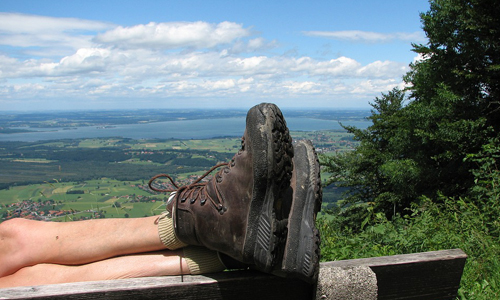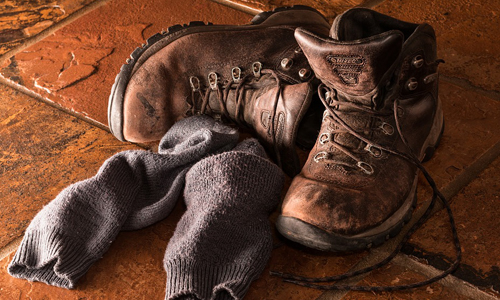Tips on how to select the right hiking boots
For your next hiking trip the footwear you choose play a crucial role in keeping you moving and ensuring that you are not limited from blisters rashes or other footwear related injuries. Here are the different types of hiking boots you can choose from to experience the best hiking trip!
The Hiking Trail – There are three types of boots to choose from, depending on the type of hike plan to go on -
- High-Cut Boots – These boots make for a comfortable fit if the trail is uneven and the trip is for more than 3-4 days.
- Low-Cut Boots – If you are going on a short one day hike covering a smooth ground these boots would be a perfect fit.
- Mid-Cut Boots – Planning to cover a 3-4 days’ long trek on a smooth ground? Mid-Cut Boots would be a comfortable option for you.
Arch of the Foot – You need to ensure that whichever boots you buy have great arch support for balancing and shock absorption. The height of heel should not be too much as they are not at all appropriate when it comes to hiking.
Material is Important – While choosing your hiking boots, check out what it is made of. For a hike it would be beneficial to opt for shoes with hard sole as they provide you with a tight grip. When it comes to material of the boots, it is all about the choice. Although leather is the best fit if you are looking for water resistance and durability, if your preference is the kind of shoes that are made from breathable and light material, go for fabric shoes.
It Fits – An important thing while purchasing hiking boots is their fitting and size. Boots with a tight fit would not fall off but they would definitely cause swelling and blisters due to sweat. That does not mean loose shoes would be a good fit as they would also cause a lot of problems. On a safer side, whenever you go shoe shopping, measure both of your feet separately and select a bigger size. Before making the final purchase, try the shoes with kind of socks that you would normally use on your hike as it would give you the perfect idea of fit and comfort.  A key point with the fit is that the boots need to let your toes breathe and allow full circulation to your feet whether you plan to wear light or thick socks.
A key point with the fit is that the boots need to let your toes breathe and allow full circulation to your feet whether you plan to wear light or thick socks.
Once you have made the purchase break in the boots before you take them out on the trail. This will ensure that you are not restricted from them rubbing, causing blisters and sores which will need treating along the way.
Categories
- Sport (28)
- Product Reviews (3)
- Team Outdoor Look (7)
- Mike Wild (2)
- Mike Payton (2)
- Suse Hammond-Pears (3)
- Snowboarding (12)
- Latest Offers (105)
- Shop Talk (1)
- Competitions (7)
- Walking (413)
- Lifestyle Fashion (8)
- Travel (86)
- Kit Guides (176)
- Workwear Clothing (6)
- Safety Workwear (4)
- Health/Fitness (289)
- Skiing (91)
- Great Outdoors (1316)
- Cycling (92)
- January 2025
- December 2024
- November 2024
- October 2024
- September 2024
- August 2024
- July 2024
- June 2024
- May 2024
- April 2024
- March 2024
- February 2024
- January 2024
- December 2023
- November 2023
- October 2023
- September 2023
- August 2023
- July 2023
- June 2023
- May 2023
- April 2023
- March 2023
- February 2023
- January 2023
- December 2022
- November 2022
- October 2022
- September 2022
- August 2022
- July 2022
- June 2022
- May 2022
- April 2022
- March 2022
- February 2022
- January 2022
- December 2021
- November 2021
- October 2021
- September 2021
- August 2021
- July 2021
- June 2021
- May 2021
- April 2021
- March 2021
- February 2021
- January 2021
- December 2020
- November 2020
- October 2020
- September 2020
- August 2020
- July 2020
- June 2020
- May 2020
- April 2020
- March 2020
- February 2020
- January 2020
- December 2019
- November 2019
- October 2019
- September 2019
- August 2019
- July 2019
- June 2019
- May 2019
- April 2019
- March 2019
- February 2019
- January 2019
- December 2018
- November 2018
- October 2018
- September 2018
- August 2018
- July 2018
- June 2018
- May 2018
- April 2018
- March 2018
- February 2018
- January 2018
- December 2017
- November 2017
- October 2017
- September 2017
- August 2017
- July 2017
- June 2017
- May 2017
- April 2017
- March 2017
- February 2017
- January 2017
- December 2016
- November 2016
- October 2016
- September 2016
- August 2016
- July 2016
- June 2016
- May 2016
- April 2016
- March 2016
- February 2016
- January 2016
- December 2015
- November 2015
- October 2015
- September 2015
- August 2015
- July 2015
- June 2015
- May 2015
- April 2015
- March 2015
- February 2015
- January 2015
- December 2014
- November 2014
- October 2014
- September 2014
- August 2014
- July 2014
- June 2014
- May 2014
- April 2014
- March 2014
- February 2014
- January 2014
- December 2013
- November 2013
- October 2013
- September 2013
- August 2013
- July 2013
- June 2013
- May 2013
- April 2013
- March 2013
- February 2013
- January 2013
- December 2012
- November 2012
- October 2012
- September 2012
- August 2012
- July 2012
- June 2012
- May 2012
- April 2012
- March 2012
- February 2012
- January 2012
- December 2011
- November 2011
- October 2011
- September 2011
- August 2011
- May 2010
- April 2010
- March 2010
- February 2010
- January 2010
- November 2009
- October 2009
- September 2009
Submit a Comment